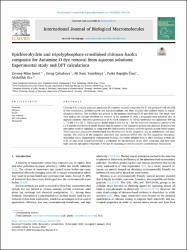| dc.contributor.author | Hasdemir, Zeynep Mine | |
| dc.contributor.author | Çetinkaya, Serap | |
| dc.contributor.author | Yenidünya, Ali Fazıl | |
| dc.contributor.author | Başoğlu-Ünal, Faika | |
| dc.contributor.author | Ece, Abdulilah | |
| dc.date.accessioned | 2023-04-03T05:32:43Z | |
| dc.date.available | 2023-04-03T05:32:43Z | |
| dc.date.issued | 28.02.2022 | tr |
| dc.identifier.uri | https://hdl.handle.net/20.500.12418/13236 | |
| dc.description.abstract | Chitosan (Ch, a natural polymer) and kaolin (K, a natural mineral) composite (Ch-K) was produced with the help of two crosslinkers, epichlorohydrin and tripolyphosphate, and then moulded into uniform beads in tripolyphosphate solution. The synthesis was proved by the analyses involving FT-IR and SEM-EDX. The beads were then used as the natural adsorbent for removal of the auramine O (AO), a frequently-used industrial dye, in aqueous solutions. Adsorbent performance of the Ch-K composite for AO dye molecules was optimized: 500 mg L−1 at pH 7.5 at 25 °C. The Langmuir model found 0.118 mol kg−1 for the maximum adsorption capacity of the Ch-K and the D-R isotherm model showed that the nature of the adsorption process was physical. Kinetics of the adsorption could be explained by using both IPD (intraparticle diffusion) and PSO (pseudo second order) models. Thermodynamic parameters demonstrated that the behaviour of the adsorption was an endothermic and spontaneous. The activity of the composite adsorbent was recovered (88%) after the five sequential adsorption/desorption cycles. Supported by experimental findings, the results obtained from in silico modeling at M06-2X/6–31+G (d,p) level helped hypothesise a mechanism for the formation of the Ch-K composite, and shed some light onto the adsorption behaviour of AO dye by assuming several favourable intermolecular interactions. | tr |
| dc.language.iso | eng | tr |
| dc.publisher | Elsevier | tr |
| dc.relation.isversionof | 10.1016/j.ijbiomac.2022.01.008 | tr |
| dc.rights | info:eu-repo/semantics/openAccess | tr |
| dc.subject | Chitosan, Kaolin, Dye, removal, DFT, calculations, Mechanism | tr |
| dc.title | Epichlorohydrin and tripolyphosphate-crosslinked chitosan–kaolin composite for Auramine O dye removal from aqueous solutions: Experimental study and DFT calculations | tr |
| dc.type | article | tr |
| dc.relation.journal | International Journal of Biological Macromolecules | tr |
| dc.contributor.department | Fen Fakültesi | tr |
| dc.contributor.authorID | https://orcid.org/0000-0001-7372-1704 | tr |
| dc.identifier.volume | 199 | tr |
| dc.identifier.endpage | 330 | tr |
| dc.identifier.startpage | 318 | tr |
| dc.relation.publicationcategory | Uluslararası Hakemli Dergide Makale - Kurum Öğretim Elemanı | tr |















